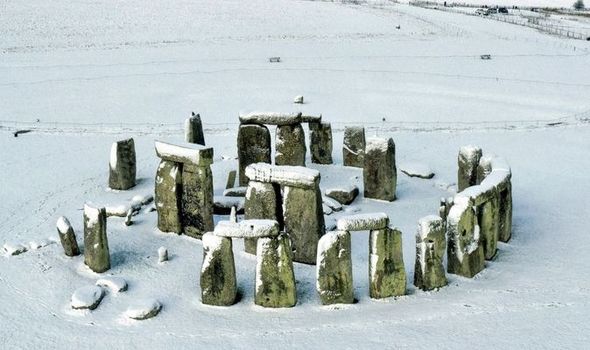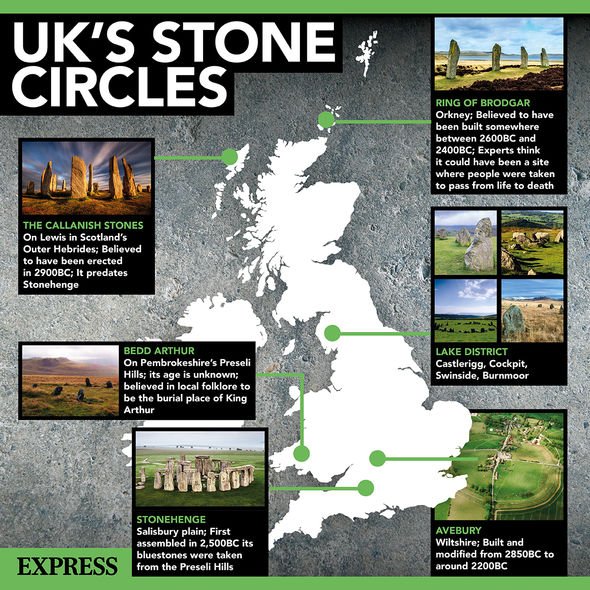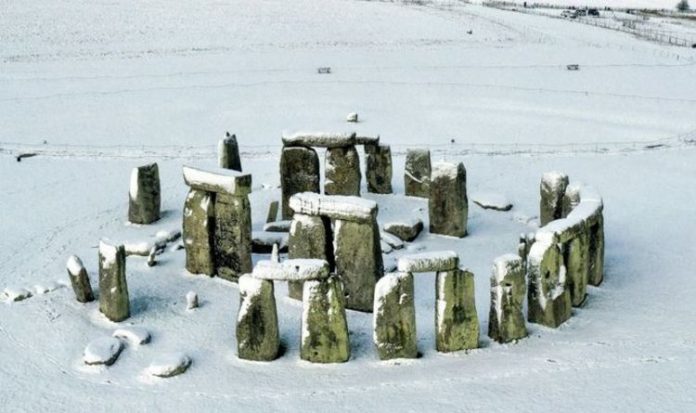Stonehenge: Transportation of Welsh stones discussed by expert
The story of Stonehenge took a dramatic turn earlier this month after researchers uncovered the remains of the Waun Mawn site at Pembrokeshire’s Preseli Hills, southwest Wales. Its discovery quickly proved to be one of Britain’s biggest and oldest stone circles, and could be the original building blocks of Stonehenge. Researchers believe the stones might have been taken apart and rebuilt 150 miles away, on Salisbury Plain in Wiltshire, where it stands today, first built in 25000 BC.
While Stonehenge is one of the country’s most famous stone circle formations, countless others are dotted all around the isles.
They can be found in Cornwall, Dorset, South Wales, the Lake District, Scotland, even as far north as the Orkney Islands.
Here are five of the most notable stone circles in the UK, including the famous Stonehenge.
Bedd Arthur
Bedd Arthur has been closely linked to Stonehenge, although no comprehensive study has been opened into how much they share in common.
Located in Pembrokeshire’s Preseli mountain range, it is unclear when the circle was first erected.
It is believed that it was once on top of a mound that disappeared 4,800 years ago or so.
According to local folklore, Bedd Arthur – which translates from Welsh as ‘Arthur’s Grave’ – is the resting place of King Arthur.
Researchers thus think that it may have originally served as a tomb, although whether Arthur is truly buried there remains unknown.

Stonehenge: The UK is filled with mysterious stone circles similar to that seen at Stonehenge (Image: GETTY)

A303 tunnel: Protestors occupy the site in reaction to the controversial A303 tunnel (Image: GETTY)
Ring of Brodgar
Planted on Orkney’s mainland island, Scotland, the mysterious rock formation has escaped the understanding of archaeologists for years.
Only 27 of the structure’s 60 stones survive today, with the site, according to researchers, having been occupied for 1,500 years from as early as 3,500 BC.
Like Bedd Arthur, whatever the Ring was used for in Neolithic times isn’t exactly clear.
However, excavations at the site suggest that it was once used as a place of religious ritual, perhaps enabling the passage of people from life to death.
In 2016, Elaine Clarke, the site’s World Heritage Ranger admitted: “We don’t know why 5,000 years ago people were building these stone circles.”
JUST IN: Stonehenge breakthrough: Monument’s ‘true purpose’ was defence

Bedd Arthur: The site is believed to be the resting place of King Arthur, on the Preseli Hills (Image: Google Maps)
The Callanish Stones
The Callanish, or Calanais Stones, are an extraordinary cross-shaped structure of stones first erected 5,000 years ago.
They predate Stonehenge, and were an important place of worship for at least 2,000 years.
Located 12 miles west of Stornoway on the island of Lewis, the circle is as far flung as it gets.
Again, researchers are not entirely sure as to why the stones were first put there.
According to archaeologist Patrick Ashmore, who excavated the site in the Eighties: “The most attractive explanation… is that every 18.6 years, the moon skims especially low over the southern hills.
“It seems to dance along them, like a great god visiting the earth.
“Knowledge and prediction of this heavenly event gave earthly authority to those who watched the skies.”
This has led many to believe that the circle was once used as an ancient astronomical observatory.
DON’T MISS
Stonehenge discovery: ‘Hidden features’ of ‘invisible’ site uncovered [REPORT]
Archaeologists baffled by ‘Scotland’s Stonehenge’ site [INSIGHT]
End of the world: Monument with guidelines to ‘rebuild civilisation’ [ANALYSIS]

Ring of Brodgar: The stone circles sits in the far flung Orkney Islands, Scotland (Image: GETTY)

The Callanish Stones: Ancient peoples are believed to have used the structure to observe the sky (Image: GETTY)
Avebury
Avebury henge and stone circles, as described by English Heritage, “are one of the greatest marvels of prehistoric Britain”.
Built roughly around 2850 BC, the formation was continuously altered until 2200 BC.
It survives today as a huge circular bank and ditch, encircling an area that includes part of Avebury Village, Wiltshire.
Within the henge is Britain’s largest stone circle.
Originally, 100 stones were lined up, these having enclosed two smaller stone circles.
Averbury was once a Neolithic and Bronze Age site, that once formed a vast landscape, including West Kennet Avenue, West Kennet Long Barrow, The Sanctuary, Windmill Hill, and the mysterious Silbury Hill.

UK’s stone circles: Britain is full of the Neolithic and Bronze Age structures (Image: Express Newspapers)
Stonehenge
Stonehenge has over the years offered up countless relics from a bygone era.
Earlier this month, site workers dug up two prehistoric bodies near to what will soon become a tunnel for the controversial A303 project.
A piece of Bronze Age industrial land was pulled up, believed to have belonged to the ancient “Beaker” culture people who arrived in Britain around 2,500 BC.
The first stage of Stonehenge is thought to have started around 5,000 years ago.

Avebury: Located in Wiltshire, Avebury henge contains Britain’s largest stone circle (Image: GETTY)
Several stages saw it finalised over the preceding centuries.
Located on the vast Salisbury Plain, the reason for Stonehenge has stumped researchers for decades.
While some say it was used as a place to sacrifice things to the gods, others claim it was used in a similar way to the Callanish Stones: to observe the sky.
Others still say it was intended as a site of pilgrimage, or as a final resting place for royalty.







